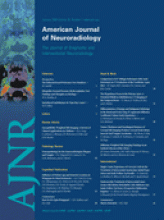The article in this month's American Journal of Neuroradiology by Albayram et al (“Gadolinium-Enhanced MR Cisternography to Evaluate Dural Leaks in Intracranial Hypotension Syndrome”)1 reviews the authors’ experience with intrathecal gadolinium administration for the detection of CSF fistulas resulting in spontaneous intracranial hypotension (SIH). In their report, the authors reviewed 19 patients with clinical SIH in whom 0.5 mL of gadopentetate dimeglumine diluted with 4 mL of saline was instilled intrathecally 1 hour before fat-suppressed T1-weighted MR imaging. They found CSF fistulas in 17 of 19 patients; 14 of the fistulas were subsequently confirmed, but in 3, the exact site of the fistula was not identified due to the gross extent of leakage by the time the MR imaging was performed. Ten patients had a single fistula, whereas 4 patients had multiple fistulas (2 tears in 3 patients and multiple tears in 1 patient). Of importance, 4 patients, all with meningeal diverticula, showed only paravertebral leakage without prominent epidural leakage. Although the authors did not routinely compare intrathecal MR myelography with CT cisternography, 2 patients did have both studies, and 1 of these showed leakage along a nerve root on MR myelography that was not visible by using CT myelography. Clinically, no patients were found to have an untoward reaction, behavioral changes, or evidence of toxicity at 24 hours and at 6–12 months following the examination.
Di Chiro et al2 first used intrathecal gadolinium to detect intracranial CSF fistulas in Beagle dogs (Beagles apparently occasionally have spontaneous CSF rhinorrhea). Using gadolinium MR cisternography, they identified fistulas in 2 dogs that had been previously found to have CSF rhinorrhea by radioisotope cisternography. In 1999, Jinkins et al3 administered cisternal gadolinium to rabbits, showing no behavioral effects, good cisternal contrast, but “gradual diffusion of the gadolinium into the cranial parenchyma … on the delayed MR studies (45 minutes–6 hours), as revealed by progressive generalized enhancement of the brain.” Zeng et al,4 from the same group, first piloted the technique in humans, showing excellent opacification and no gross behavioral changes following the instillation of 0.2 mL, 0.5 mL, or 1 mL of gadopentetate dimeglumine (500 mmol/L) diluted in 5 mL of CSF. Although long-term safety studies have yet to be performed, histologic studies in animals have shown no changes concerning acute toxicity of intrathecal gadolinium, and a recent international registry study of 95 humans reported no significant toxicity of 0.5–1 mL of intrathecally administered gadopentetate dimegulmine.5 Aydin et al6 reported that gadolinium cisternography demonstrated leaks in 2 patients with negative findings on CT cisternography, and Tali et al7 used gadolinium cisternography to determine the communication between the CSF pathways and intracranial arachnoid cysts. Although the spatial resolution of MR imaging is typically less than that achieved by using CT myelography, the lack of ionizing radiation and better contrast resolution are enticing factors that make MR imaging a viable alternative to CT, especially in children and in those in whom subtle or slow leaks are suspected.8
I have personally used gadolinium cisternography in several patients with SIH who had difficult-to-detect spinal fistulas. After obtaining informed consent from the patients, I diluted 0.5 mL of gadopentetate dimegulmine with 5 mL of iohexol (Omnipaque 180; GE Healthcare, Piscataway, NJ) and slowly injected this mixture intrathecally during a 3-minute period. The patients tolerated this procedure well and had no immediate or subacute side effects, and the technique allowed me to study the patients first with CT myelography, followed by MR myelography. Radioisotopes could also be administered at the same time by using a single spinal puncture.
Obviously gadolinium cisternography brings up concerns regarding the safety of the intrathecal use of gadolinium-based contrast agents. The intrathecal use of gadolinium is not currently FDA-approved. The off-label use of these compounds should be considered carefully and used only in patients with normal renal function and CSF clearance in whom currently accepted techniques for detecting CSF dynamics or leaks are either unrevealing or associated with unacceptable potential consequences or risks. Central nervous system (CNS) toxicity following the intravenous use of gadolinium in a patient with renal failure has been reported.9 In addition, Morris and Miller10 reported that the increased signal intensity in the subarachnoid space detected on fluid-attenuated inversion recovery imaging of the brain in patients following previous intravenous gadolinium injections is secondary to contrast agent crossing the intact blood-brain barrier in both healthy patients as well as those with renal failure. There are, no doubt, differences in the CSF clearance among the various compounds as well among patients with various renal clearances, ages, and underlying CNS disorders. The direct enhancement of brain as observed in rabbits by Jinkins3 (see above) is also a concern that the brain is at risk for toxicity if CSF clearance is impaired or an improper dose is administered. These questions must obviously be addressed before general use of these agents intrathecally.
All that said, gadolinium MR myelography and cisternography may potentially better evaluate obstruction of the subarachnoid space, arachnoid cysts, spontaneous or traumatic intracranial and spinal CSF fistulas, and CSF dynamics. The lack of ionizing radiation, availability of multiplanar views, and the potential to assess dynamics of CSF over time without concern for radiation are appealing aspects of MR imaging–based techniques. However, as we have learned only too clearly from the recent data on nephrogenic systemic sclerosis and its association with gadolinium contrast agents in patients with renal impairment, additional animal and human studies must be performed to further evaluate the long-term safety as well as to prove the clinical efficacy of this procedure in a larger number of human subjects.11 Because the elimination of gadolinium from the CSF compartment has different kinetics than that administered intravenously, the lack of brain and spinal toxicity over the long term must be established before widespread use of this technique is acceptable. Nonetheless, the potential for increased contrast resolution coupled with reduction in radiation exposure is seductive. Its time may have come.
References
- Copyright © American Society of Neuroradiology












